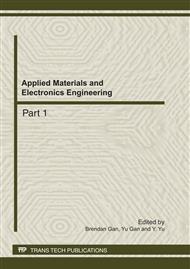p.619
p.623
p.628
p.632
p.636
p.642
p.646
p.650
p.655
Study of Dye-Sensitized Solar Cells with Nanostructure Inn Compact Layer and Au Nano Particles
Abstract:
This study examined the nanostructure InN compact layer and Au nano particles to dye-sensitized solar cells (DSSCs).We presents the DSSCs with Nitrided indium compact layer (InN-CPL) prepared by radiofrequency magnetron sputtering and doping Au particle in photoelectrode. The InN-CPL effectively reduces the back reaction in the interface between the indium tin oxide (ITO) transparent conductive film and the electrolyte in the DSSC. The Au particles effect conduction band of the TiO2 to rise open-circuit voltage to 0.7 v. The Au particles effectively rise inject electrons efficiency. For the DSSC without InN-CPL, the short-circuit current density and solar energy conversion efficiency are 15.6 mA/cm2 and 6.35 %, respectively. However, DSSCs with InN-CPL effectively rise short-circuit current density. The DSSC fabricated on 90 nm InN-CPL and doping Au particle showed the maximum power conversion efficiency of 8.9 % (AM1.5G) due to effective prevention of the electron transfer to electrolyte.
Info:
Periodical:
Pages:
636-641
Citation:
Online since:
October 2011
Authors:
Price:
Сopyright:
© 2012 Trans Tech Publications Ltd. All Rights Reserved
Share:
Citation:



